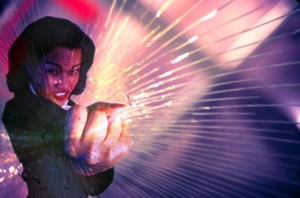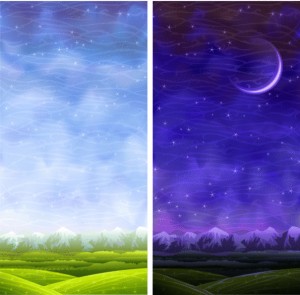The History of Histories (Part 12)
By Asher Crispe: November 14, 2012: Category Inspirations, Quest of the Question
Dual Deeds and Free Agents
 In the last article we addressed the first two levels of history as they related to the year and the month, now we will move on to address the time signature of the two higher levels which correspond to the week and the day respectively.
In the last article we addressed the first two levels of history as they related to the year and the month, now we will move on to address the time signature of the two higher levels which correspond to the week and the day respectively.
3) Human History
When we introduced the concept of the breaking of the vessels in Kabbalah, we cited the Torah recording of a strange lineage of Edomite Kings. While eight in number, only seven of them die. These seven constitute the basic forces at work within the World of Chaos. For the Arizal, this set of seven correlates in one to one fashion with the seven days of the week.
One of the contexts where this ‘week’ as the time frame for the World of Chaos comes up is in the Hebrew month of Elul. The sages have long established that the world was created on the 25th of the month of Elul and that the first week of Creation that is described in Genesis runs from the 25th to the first of the following month of Tishrai. While this week functions as the set up for the World of Rectification, according to the general principle that chaos precedes order (or more specifically that the World of Chaos precedes the World of Rectification), we can also find a corresponding week of Chaos that starts the week before the 25th. This is exactly what the Arizal teaches: from the 18th of Elul on until the 25th there is an unstable proto-Creation associated with the World of Chaos.
In the soul, the framework of the week is likened to the seven emotive spheres. When one emotion tries to overpower all of the others in a contest for the whole of a person’s attention, then the intensity of that feeling builds up to the exclusion of all of the other feelings. The breaking of the vessels, therefore, relates primarily to the shattering of the vessels of the heart. On average, this ‘abstract’ broken heart lasts an entire week. Note that shivah (which literally means ‘seven’) is the week of mourning according to Jewish custom. Likewise, it is customary to celebrate the joy of a wedding with sheva brachot or seven blessing which are recited at a festive meal for the entire week after the wedding. When the feelings are that intense, its takes a week to process through one’s emotive system.
So too, the timing of human history is highly emotionally charged. Throughout the ages, the forces of human history are largely overwhelming expressions of various characters who grab at power to the exclusion of others. Subsequently, the end of history occurs when all of the emotions settle down and are able to coexist.
4) Cosmic History
A simplified version of cosmic history might be expressed in words of Genesis 1:5 “God called the light day, and the darkness He called Night. An there was evening and there was morning, one day.” According to Kabbalah, what this is telling us is that both Night and Day are called day. Day is the Night/Day or Darkness/Light cycle. Yet, what we call light is only the finite after-glow of the original infinite light that filled all of reality prior to Creation. The act of hiding this infinite light, as we have already explained, is called tzimtzum or contraction. Cosmic history is the study of this light and darkness. Whether it be looking for dark energy or dark matter or the echo of the Big Bang, scientists are tracking the exchanges of light and darkness and trying to make light of it all.
On day one of Creation, the Torah does not say it was yom rishon (the first day) but rather yom echad meaning the day of the One. This ‘day’ as a framework of time marks the event of Divine concealment and the advent of a natural world order. The natural world order in Jewish mysticism is the greatest Night. It is a metaphysical Night in fact. Day as a Metaphysical Day (where the infinite light of the Creator shines without restriction, where the transcendent aspect of Divinity is revealed) couples with metaphysical Night. The evening of Divinity manifest as nature joins the morning of Divinity manifest as beyond nature and the unity of both is all One day. When this highest unity–the marriage of Night and Day–becomes conscious then everything will convert into being day. Then even the darkness will shine as it says in Psalms 139:12 “…and night shines like the day; the darkness is as the light.”
 In the end of cosmic history, all of the natural world will provide a source of spiritual illumination. Even the concealment of the Divine contraction itself will become a source of light and will reveal to us some of the deepest secrets of Divinity. This implies that we will have not only new light but a new light source–the lamp of darkness itself. In a certain sense all of the lower order histories are just a miniature theater for this greatest of mysteries. Therefore, everything that might have been antithetical to the Divine will and purpose in Creation is meant to eventually become an illumination of that will. With time the paradox will work itself out. For us what matters most is that the production of history came from hiding and not denying or deleting the end of history.*
In the end of cosmic history, all of the natural world will provide a source of spiritual illumination. Even the concealment of the Divine contraction itself will become a source of light and will reveal to us some of the deepest secrets of Divinity. This implies that we will have not only new light but a new light source–the lamp of darkness itself. In a certain sense all of the lower order histories are just a miniature theater for this greatest of mysteries. Therefore, everything that might have been antithetical to the Divine will and purpose in Creation is meant to eventually become an illumination of that will. With time the paradox will work itself out. For us what matters most is that the production of history came from hiding and not denying or deleting the end of history.*
A note on sources: much of the material for this series of articles was taken from an untranslated discourse of Rabbi Yitzchak Ginsburgh entitled “Norah Alilah al Benai Adam” which appears in Mivchar Shiurei Hahitbonnenut Vol. 8 pp.13-53.
http://www.interinclusion.org/inspirations/the-history-of-histories-part-11/
http://www.interinclusion.org/inspirations/the-history-of-histories-part-1/























;)
;)
;)
;)
;)
;)
;)
;)
;)
;)
